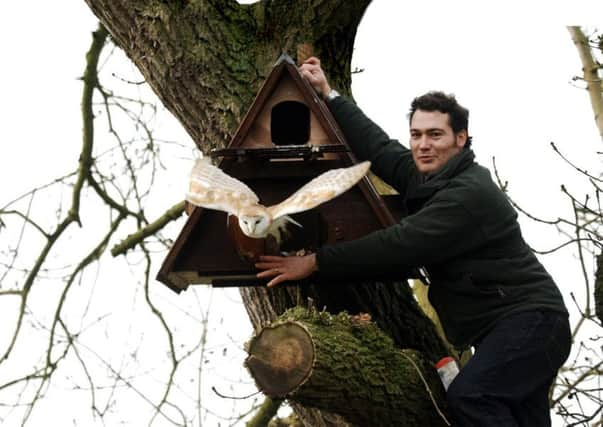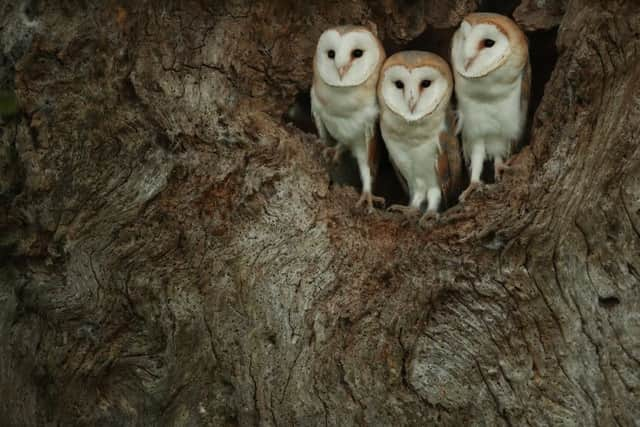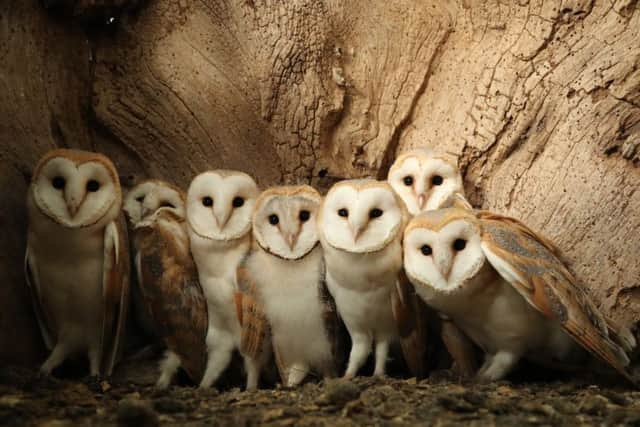Fuller: Barn owl patrol yields great result on the Wolds


Barn owls are one of my favourite birds to study and paint. I’m so fond of these beautiful birds of prey I personally monitor their progress across the Yorkshire Wolds and send my findings to the British Ornithological Trust (BTO) for their annual census.
It all began back in 1998 when I first moved to Thixendale. There were no breeding pairs of barn owls close to my gallery at that time, and very few places for barn owls to nest.
Advertisement
Hide AdAdvertisement
Hide AdI was contacted by a local farmer who had found three barn owl chicks in the floor of his barn while it was being emptied of straw bales. There was a tower of bales still left in the corner of the barn so I put a nest box on top of it. Luckily the parent birds accepted the new arrangement and fed the chicks in this new site. After the young had fledged I moved the nest box to a nearby shed so the adult pair had a safe place to nest the following year.


Over the years putting up nest boxes has led to a much wider barn owl conservation project covering an extensive region, which I run in conjunction with other like-minded people. To date I’ve put up 150 nest boxes on farmland across the Wolds.
I haven’t time to monitor all the boxes, but each year I load a set of ladders onto the roof of my vehicle to see how the owls are doing. I usually make my way around about 30 of them and send off by findings to the BTO in autumn.
During severe winters their prey can disappear under the thick covering of snow, making hunting difficult. After one particularly cold season I began offering the barn owl pair living closest to my gallery extra food to help them survive. I’ve continued to supplement the diet of this pair and they still nest here.
Advertisement
Hide AdAdvertisement
Hide AdI monitor their daily activities from a nearby hide and via cameras mounted both inside and outside of their nest boxes. This year the female laid five eggs. After 29 days the first chick hatched followed every few days by a further three.


Shortly afterwards I was contacted by Selby Wildlife Rescue Centre. Two small barn owl chicks had been handed in. They were wet and cold and likely to perish after the tree their nest was in was blown down in a storm.
I suggested that I put the rescued owls into the nest close to the bottom of my garden, where I could keep an eye on them via the hidden cameras. I’ve done this before and been successful. Since owls cannot count, the adults just presume these extra chicks are theirs and get on with feeding and caring for them.
I watched my cameras carefully to make sure the adults accepted the new chicks. They did so without batting an eye. Within two weeks a further two rescued owlets came in, from Ryedale Rehabilitation Centre. Again these chicks were accepted by my local pair without a fuss. The adults now had a super-brood of eight youngsters.
Advertisement
Hide AdAdvertisement
Hide AdBarn owlets are known for attacking younger and smaller siblings when times are hard and cannibalism is a reality. There is typically a significant difference in size between the biggest and smallest owlets, as the parents incubate their eggs as soon as each one is laid.


If the female lays a clutch of eggs, the first chick will hatch at least 10-15 days before the last chick.
Watching via my cameras in the nest, the eight owlets were in a mish-mash of sizes. I upped the amount of food that I put out for them to make sure the adults could cope with these extra mouths to feed.
I fed the adults dead chicken chicks, which I buy in frozen by the 1,000. These dead chicks are cockerels, a by-product from the hen-laying industry. Usually I allocate two a day per owl. And if the weather is bad I up this to three. This, along with the voles that the adult birds hunt every day, is enough for the barn owlets to thrive.
Advertisement
Hide AdAdvertisement
Hide AdIn May I tore the ligaments in my ankle and was unable to embark on my annual census of barn owl boxes until July 9, which is a little late in the season. I was afraid that many owlets would have already fledged.


Nevertheless I set off in the company of two associates, one to ring each new chick, and a second to record the data on each barn owl box.
It was a really successful survey. Box after box had young barn owls in. I suspected it’d been a good year regionally since I had seen my local pair bring plenty of voles into their nest, but I hadn’t really appreciated just how healthy the broods were.
The first nest box I inspected had five young owls inside, all fully feathered, and they flew out as soon as I approached the tree with my ladder.
Advertisement
Hide AdAdvertisement
Hide AdAt the second box, I was more successful, finding three young owls inside. I lifted each owlet and placed them into separate compartments of a canvas shoulder bag to ensure that the chicks didn’t claw at each other as I made my way down the ladder. At the bottom, I lifted each owlet out so it could be ringed. Each numbered ring is clamped around one leg. The ring number is then recorded along with the details of each bird: where it hatched, its approximate age and size. Once this was done I took put the chicks back into the nest.
As I made my way down the ladder, I saw four other owls perched close by: the adult pair and two owlets that had recently fledged - meaning these owls had also had a clutch of five.
These are big broods for the Wolds, where barn owls can struggle to survive at this altitude.
At the next box, a barn owl flew out just as I placed my ladder against the tree. It was a young male. I paused for a moment to watch its slightly wobbly flight before it landed close by in an ash tree.
Advertisement
Hide AdAdvertisement
Hide AdI continued up the ladder just as an adult female took off. Inside I found a further two chicks. This box had only ever had barn owls breeding in it on two occasions before so it was great to see that it was in use again.
There were barn owls in each box I checked that day. I can’t describe the sense of satisfaction I felt. How different from the day I moved to Thixendale 20 years ago.
BARN OWL FACTS
Barn owls are widespread and can be found in every continent apart from Antarctica.
In the UK, in the most northern part of their range, populations can be fragile.
Advertisement
Hide AdAdvertisement
Hide AdTheir diet consists of small rodents: mice, shrews and most importantly voles. The size of the population of the latter peaks and troughs considerably, which in turn affects the numbers of owls and particularly their breeding success.
Most females have spotted chests and males are usually all white.